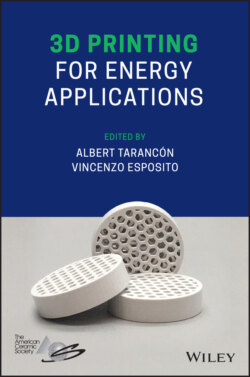Читать книгу 3D Printing for Energy Applications - Группа авторов - Страница 32
1.5.3 Additive Manufacture
ОглавлениеFor powder‐bed binder jetting and vat photopolymerization, certain industrially available systems are tailored for the hybrid AM process chain [96]. Examples are the Desktop Metal and ExOne (metals) system for binder jetting and the Lithoz system for vat photopolymerization (ceramics/metals). Given that these systems are tailored to the process chain, the workflow from CAD body design, through debinding to sintering, is offered as a bundled solution that minimizes the efforts needed for successful adoption. For experimental binder/matrix materials, the readily available industrial systems are less suited, as these are qualified to operate solely in a palette of materials offered by the systems provider. For exotic materials, a custom system is needed that allows for an open parameter setup in order to optimize the build for the feedstock chosen. Such solutions are not readily available and require an initial effort in setting up a custom AM system by the adopter, raising the barrier, therefore tremendously.
Figure 1.6 Schematic of the hybrid metal AM process chain through sintering. DfAM refers to Design for AM and VPAM refers to Vat‐photo‐polymerization AM.
Source: A part of the figure is adapted in accordance with the Creative Commons license and is a copyright of Holo Inc. [94]. © 2020 John Wiley & Sons.
For filament extrusion hybrid AM, there is an abundance of capable entry‐level systems that allow for a free selection of filament [97]. The powder‐loaded filaments for hybrid AM are offered by renowned providers (e.g., BASF) and often accompanied with technical white‐papers, aiding the operator of the system in achieving a successful AM build, debind, and sintering. The matrix polymer is often the same polymer as general‐purpose feedstock (e.g., polylactic acid), and the powdered filler is often stainless steel (e.g., 316L). Take due notice that some filaments are loaded with metal particles for aesthetic reasons only. Filaments with bronze or copper are often employed to give the additively manufactured part an aesthetic sculpted appearance that will oxidize and wither through time due to exposure to the elements. These materials are not suitable for hybrid AM. The build of a component with a suitable filament for hybrid AM manufacture requires different processing conditions than those of a standard filament. The extrusion temperature is generally increased to aid flowability, and since the extrusion pressure/force is higher due to the altered rheology of the feedstock, a direct drive extruder drive mechanism is favored. Retrofitting a dual traction extruder drive system is oftentimes offered as a drop‐in replacement for entry‐level filament AM system.
